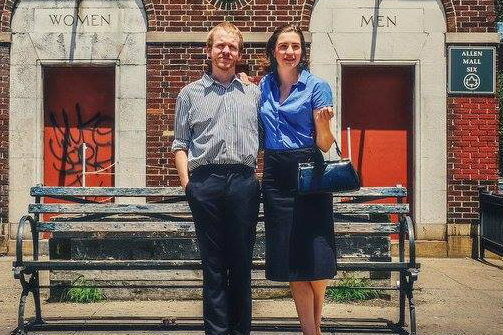J & K 1965
Written and Directed by Carlo D'Amore
Produced by Live In Theater
Off Off Broadway, Play
Runs through 7.30.17
Sara D. Roosevelt Park, Southwest corner of Forsyth and East Houston Streets
by Charlotte Arnoux on 6.29.17
 Kevin Percival and Phoebe Dunn in J & K 1965.
Kevin Percival and Phoebe Dunn in J & K 1965.
BOTTOM LINE: A highly interactive site-specific hunt for heroin in a 1965 Needle Park.
In 1965, famed photojournalist Bill Eppridge's photo essay "Two Lives Lost to Heroin" was published in Life magazine. His two subjects—John and Karen—are the protagonists of Live In Theater’s newest interactive play J & K 1965, written and directed by Carlo D’Amore, the company’s creative director. Using the photos as primary source material, D’Amore has written interactions he thinks John and Karen might have had, all within the central action of trying to find money and drugs on the streets of the Lower East Side.
Live In Theater is known for its immersive experiences, earning them a Drama Desk nomination for Unique Theatrical Experience and countless media shoutouts. In J & K 1965, audience members are invited to interpret different roles through the course of John and Karen’s journey, from fellow junkies to johns, cops, and journalists. The ensemble is obviously great at what they do, seamlessly and professionally creating an environment that lends itself to play and helps the more hesitant participants commit to their roles. Indeed, I felt completely taken care of for the entirety of this performance. Needless to say, audience-actors get very well acquainted, very quickly.
Much of the colossal task of encouraging audience participation falls in the very able hands of the two performers: Kevin Percival (John) and Phoebe Dunn (Karen). The two give a compelling performance. Watching their commitment to these roles and to telling their stories without ever flinching was my favorite part of the show. Percival’s crazed-yet-gentle John is a force of nature and Dunn’s obvious empathy for Karen pierces through her pinched lips and sad eyes.
The Lower East Side’s Sara D. Roosevelt Park is the setting, even though the original Needle Park from the Life essay was on the Upper West Side. The group moves around the park and its surroundings; on a breezy, sunny day like the one I attended, this is undeniably an original way to see this neighborhood.
In his introduction to the play’s format and what we could expect, D’Amore mentioned the effect the original Life magazine article had on shedding light onto the harrowing lives of those who called the needle parks of New York home. In particular, he mentioned that having these two white protagonists enabled readers to see themselves in John and Karen, calling them to action because…well, this was happening to people who look like them.
Indeed, not much has changed with how attention is called to rampant opioid overdoses today. Black Americans have been suffering from this epidemic for years, but instead of the largely sympathetic media and political attention given to the suburban, white, middle-class victims of this atrocious outbreak, Black Americans continue to be incarcerated at alarming rates and treated like no more than “junkies.” Here lies the main source of my discomfort with seeing and participating in this play: by using the same two characters from a 1960s photo essay, are we not continuing the whitewashing (read: Black erasure) of history?
D’Amore explained to us at the end of the performance that Live In Theater is effective because it makes audiences ripe for visceral learning, to “get a greater understanding.” The problem is the disconnect between that goal and what this performance actually achieves: we are asked to remove ourselves from the realities of this park, to ignore, say, the actually homeless people exiting the Bowery Mission. With period costumes and accented characters embodying tropes we’ve all seen in Al Pacino movies, do we not move past escapism, past voyeurism, past play-acting and into, dare I say, slumming?
Site-specific theater in public spaces comes with an added challenge: the people who occupy the space are part of the set. The demographic of the park the day I saw the performance was mostly Black and Chinese. The further we got into the hunt to score some “stuff,” the more I wanted to distance myself from our group of mostly white audience-actors pretending to be drug addicts. One particular moment, when we circled up in a field populated with children, pretending to find veins for one another, shooting up, and going on a “trip,” made me want to leave.
There is a difference between the discomfort of experiencing a difficult reality through theater, and being asked to participate in something tactless and in poor taste. While no play can cover all stories, I would have loved to see these theater-makers take on the challenge of utilizing the diversity of the neighborhood they chose as the set of their play, instead of completely ignoring it. I dream of a version of this play that forces us to confront the gruesome reality of our own racial biases, a version that highlights—let alone mentions—the inextricable link between drugs and discrimination that has existed since before 1965, and that persists to this day.
(J & K 1965 plays in Sara D. Roosevelt Park, SW Corner of Forsyth and East Houston Streets, through July 30, 2017. The running time is 80 minutes with no intermission. Performances are Sundays at 2. Tickets are $49 and are available at liveintheater.com.)
J & K 1965 is written and directed by Carlo D'Amore.
The cast is Phoebe Dunn, and Kevin Percival.

